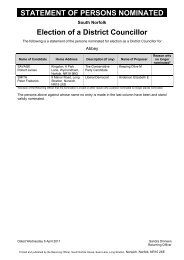Download the Transnational Ecological Network - South Norfolk ...
Download the Transnational Ecological Network - South Norfolk ...
Download the Transnational Ecological Network - South Norfolk ...
You also want an ePaper? Increase the reach of your titles
YUMPU automatically turns print PDFs into web optimized ePapers that Google loves.
TRANSNATIONAL ECOLOGICAL NETWORK PROJECTNORFOLK AND SUFFOLK BIODIVERSITY ACTION PLANSVision for Wetlandstowards Biodiversity-rich FloodplainsTHE WAVENEY & LITTLE OUSE
VISION FOR WETLANDSTOWARDS BIODIVERSITY-RICH FLOODPLAINSTHE WAVENEY AND LITTLE OUSEThe long established wetland habitats of Britainand Western Europe were home to a greatrichness of native species of plants andanimals.These continued to exist side by side with<strong>the</strong> needs of local people, who used <strong>the</strong>se areas aspart of <strong>the</strong>ir local economy over long periods of timeas grazing land, or to produce thatching materialsand o<strong>the</strong>r useful products. However, wetland areas inmuch of Britain and Western Europe have seen greatchanges in <strong>the</strong> past century. Many rivers and streamshave been straightened, deepened and o<strong>the</strong>rwiserealigned. Water quality has declined. Extraction ofwater from boreholes and improved land drainageand flood protection have led to <strong>the</strong> drying out ofparts of <strong>the</strong> floodplains. Much of <strong>the</strong> land beside <strong>the</strong>rivers, in <strong>the</strong>ir flood plains, has been drained andploughed instead of <strong>the</strong> fens, reedbeds and marshgrassland that had existed for centuries previously.Whilst <strong>the</strong>se changes were brought about to satisfy<strong>the</strong> perceived need to change land uses, reduceflooding and o<strong>the</strong>rwise ‘improve’ agriculturalproduction, <strong>the</strong> concomitant decline of <strong>the</strong> wildlifevalue and hydrological functioning of <strong>the</strong>se formerwetland habitats, and of <strong>the</strong> species <strong>the</strong>y harboured,has been severe.Assorted ducksThere is now a great wish on <strong>the</strong> part of public andvoluntary organisations with responsibilities forwildlife, landscape and <strong>the</strong> environment to seek towork in partnership with local people and <strong>the</strong> ownersof wetlands, and former wetlands, to regain some of<strong>the</strong> benefits for biodiversity that <strong>the</strong>se areas used tooffer in abundance. Biodiversity is considered as <strong>the</strong>variety of life in all its forms. As one contribution tothis effort, partners in <strong>the</strong> Ne<strong>the</strong>rlands, Germany,Denmark and <strong>the</strong> UK (Suffolk and <strong>Norfolk</strong> CountyCouncils) have formed a partnership to promoteinitiatives in <strong>the</strong>ir areas which will provide benefits forwetland habitats through a project called <strong>the</strong><strong>Transnational</strong> <strong>Ecological</strong> <strong>Network</strong> (TEN). Theseinitiatives are to be seen as demonstrations for o<strong>the</strong>rsimilar initiatives elsewhere in <strong>the</strong> partner countriesand beyond.1
The Waveney and Little Ouse rivers form <strong>the</strong> countyboundary between <strong>the</strong> two UK partners in thisproject, and accordingly, <strong>the</strong>se two floodplains havebeen selected as <strong>the</strong> UK’s pilot project. A composite‘vision’ for <strong>the</strong> possible biodiversity future of <strong>the</strong>setwo rivers’ floodplains has been prepared under <strong>the</strong>auspices of <strong>the</strong> organisations listed below. The majorprinciples of this are that:Great crested grebeVISIONThe following should be improved to <strong>the</strong>ir maximum possible potential in orderto restore or enhance habitat and landscape throughout <strong>the</strong> valley systems for<strong>the</strong> benefit of wetland wildlife and people:● Water quantity● Water quality● Sense of place● Community involvement with environmental initiatives● Public access and amenity which does not degrade <strong>the</strong> environmentalresource, including unnecessary disturbance to species.The strategic objectives of <strong>the</strong> vision are to:● Develop sustainable flood defences which provide appropriate standards to peopleand built property and contribute to <strong>the</strong> benefit of biodiversity● Raise water levels wherever appropriate, particularly in <strong>the</strong> adjacent marsh and fenareas● Return rivers to more natural channel systems● Raise <strong>the</strong> river beds, particularly where <strong>the</strong>y have been over deepened in <strong>the</strong> past● Create buffer zones to core wetlands and corridors to link <strong>the</strong>m● Actively promote land use change to wetter habitats and characteristic landscape● Achieve integrated catchment management● Prevent urban development in <strong>the</strong> flood plain● Create large scale, near naturally functioning wetlands● Create a mosaic of wetland habitats that complements <strong>the</strong> existing resource, wherepossible driven by <strong>the</strong> demands of important species and <strong>the</strong> nature of existingsoils. Typically, peatland will support fen/alder carr mosaic, while clay land willsupport grazing marsh or reed● Remove or modify bridges, weirs, sluices and o<strong>the</strong>r riverside structures wherepossible● Involve community groups and all stakeholders.This is shown in some more detail on <strong>the</strong> maps attached.2
It is envisaged that this vision should provide afoundation for <strong>the</strong> various public agencies, landownersand local people with legitimate interests for managingthis area and making <strong>the</strong>ir living from it, to worktoge<strong>the</strong>r on a voluntary basis to recreate something ofwhat has been lost. Its implementation over time willlead to significant benefits for biodiversity in this part of<strong>Norfolk</strong> and Suffolk. Benefits will accrue to nationallytargeted biodiversity habitats such as floodplaingrazing marsh, reedbed, fen, wet woodland, standingwaters and small areas of lowland heath, and to anumber of species such as otter, water vole andmolluscs such as Desmoulin’s snail.OtterIt is not expected that <strong>the</strong> vision will become reality in ashort time. There is too much to achieve. Ra<strong>the</strong>r, if justa small part of <strong>the</strong> vision could be realised over <strong>the</strong>next ten to twenty years, that would representconsiderable success. Working collaboratively inpartnership with all interests should bring real benefitsfor all. Long-term programmes of work funded bypublic agencies could be integrated to deliver parts of<strong>the</strong> vision, bringing benefits for biodiversity and for <strong>the</strong>enjoyment of local people. There will be a redirection ofagricultural support systems in <strong>the</strong> course of time, andthis could contribute to this aim. This is alreadyoccurring, for example, through <strong>the</strong> Rural DevelopmentProgramme, which represents a significantredistribution of money for rural communityenhancement.We hope that local people, and especially those whoown <strong>the</strong> land, will be interested in some of <strong>the</strong> ideascontained in this vision. It would not be necessary foreveryone to ‘come on board’ at once, but someenthusiastic partners will be needed to get <strong>the</strong> task ofrestoration started. O<strong>the</strong>rs can join later. Works cannotgo ahead that would not be suppprted by thoseaffected by <strong>the</strong>m. We should like to know whatpotential ‘stakeholders’ think about <strong>the</strong> vision, andwhe<strong>the</strong>r <strong>the</strong>y may wish to contribute to its realisation infuture years. If <strong>the</strong>re is some enthusiasm for realising<strong>the</strong> vision, <strong>the</strong>n <strong>the</strong> responsible organisations will seekfunding from European and national sources to help toimplement it.Scarce chaser dragonflyThis vision has been prepared by Jeremy Pursegloveof Mott MacDonald on behalf of <strong>the</strong> Waveney and LittleOuse Partnership under <strong>the</strong> auspices of <strong>the</strong><strong>Transnational</strong> <strong>Ecological</strong> <strong>Network</strong> Project, and it hasbeen accepted by both <strong>the</strong> <strong>Norfolk</strong> and SuffolkBiodiversity Action Plan Steering Groups.3
The Waveney and Little Ouse Partnership is made upof representatives of <strong>the</strong> organisations set out below:● <strong>Norfolk</strong> County Council● Suffolk County Council● English Nature - <strong>Norfolk</strong> and Suffolk Teams● Environment Agency - Eastern and Central Areas of<strong>the</strong> Anglian Region● Anglian Otters and Rivers Project● Blo’ Norton and Thelnetham Conservation Volunteers● <strong>South</strong> <strong>Norfolk</strong> District Council● Broads Authority● Department for Environment, Food and Rural Affairs- Rural Development Services● Forest Enterprise● <strong>Norfolk</strong> Wildlife Trust● Royal Society for <strong>the</strong> Protection of Birds● Suffolk Wildlife TrustBream4
A longer report is available on request setting out a littlemore of <strong>the</strong> background to <strong>the</strong> TEN (<strong>Transnational</strong><strong>Ecological</strong> <strong>Network</strong>) project and <strong>the</strong> preparation of thisvision.Graham KingCountryside Manager<strong>Norfolk</strong> County CouncilCounty HallNorwich<strong>Norfolk</strong>NR1 2SGTelephone (01603) 222762email: graham.king@norfolk.gov.ukSue HootonEcologistSuffolk County CouncilSt Edmund HouseIpswichSuffolkIP4 1LZTelephone: (01473) 583182email: sue.hooton@et.suffolkcc.gov.ukSwallowtail butterflyand milk parsley5



![List of outstanding appeals against planning decisions [PDF, 30 Kb]](https://img.yumpu.com/51294693/1/190x135/list-of-outstanding-appeals-against-planning-decisions-pdf-30-kb.jpg?quality=85)

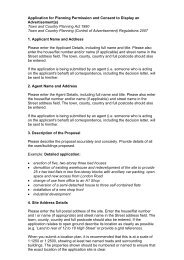
![Brown bin calendar - week 2 [PDF] - South Norfolk Council](https://img.yumpu.com/49352110/1/184x260/brown-bin-calendar-week-2-pdf-south-norfolk-council.jpg?quality=85)
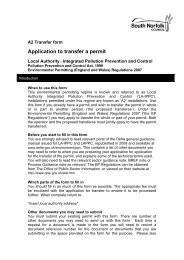

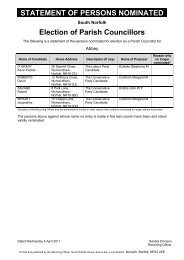
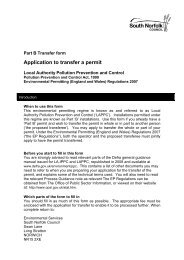
![Link magazine, Spring 2008 [PDF, 4,450k] - South Norfolk Council](https://img.yumpu.com/43994858/1/184x260/link-magazine-spring-2008-pdf-4450k-south-norfolk-council.jpg?quality=85)
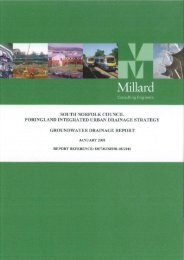
![South Norfolk Council Volunteering Opportunities [PDF]](https://img.yumpu.com/42079564/1/184x260/south-norfolk-council-volunteering-opportunities-pdf.jpg?quality=85)
![Tiffey Valley Guide [PDF, 1,450k] - South Norfolk Council](https://img.yumpu.com/41615145/1/124x260/tiffey-valley-guide-pdf-1450k-south-norfolk-council.jpg?quality=85)
![Queen's Diamond Jubilee Fund [PDF] - South Norfolk Council](https://img.yumpu.com/41088331/1/184x260/queens-diamond-jubilee-fund-pdf-south-norfolk-council.jpg?quality=85)
